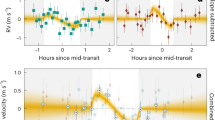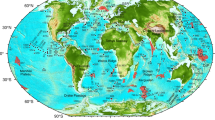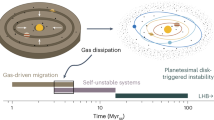Abstract
The ∼30 Myr periodicity associated with the Sun's motion through the central plane has been linked to geomagnetic reversals1,2, biological extinctions3 and crater ages4–6. This periodicity is consistent with galactic theories of terrestrial catastrophism1,5. It has been suggested, however, that the periodicity is controlled by a hypothetical stellar companion of the Sun (‘Nemesis’) in a highly eccentric orbit of arbitrarily chosen period which periodically upsets the Oort cloud7,8. Although the idea appears superficially attractive, there has been little or no attempt to relate it to what is already known about the Oort cloud and the environment in which the Sun–Nemesis system would have to exist. Thus, the inferred phase of the Nemesis cycle is inconsistent with such evidence as there may be for a recent disturbance (∼5 Myr) of the Oort cloud, namely the apparent non-equilibrium distributions of perihelia1 and 1/a (ref. 9) and the enhancement of the short-period comet population10,11 (compare ref. 12). It also discounts the generally high glacial, magnetic and orogenic activity on Earth within this period and the Sun's recent passage through Gould's belt10,13. However, the most serious problem is reconciling the approximately constant time-averaged cratering rate for the last ∼3,000 Myr (ref. 14) and the stability of the proposed system.
This is a preview of subscription content, access via your institution
Access options
Subscribe to this journal
Receive 51 print issues and online access
$199.00 per year
only $3.90 per issue
Buy this article
- Purchase on SpringerLink
- Instant access to full article PDF
Prices may be subject to local taxes which are calculated during checkout
Similar content being viewed by others
References
Clube, S. V. M. & Napier, W. M. Mon. Not. R. astr. Soc. 208, 575–588 (1984).
Negi, J. G. and Tiwari, R. K. Geophys. Res. Lett. 10, 713–716 (1983).
Raup, D. M. and Sepkoski, J. J. Proc. natn. Acad. Sci. U.S.A. 81, 801–805 (1984).
Seyfert, C. K. & Sirkin, L. A. Earth History and Plate Tectonics (Harper Row, New York, 1979).
Rampino, M. R. & Stothers, R. B. Nature 308, 709–712 (1984).
Alvarez, W. & Muller, R. A. Nature 308, 718–720 (1984).
Whitmire, D. P. & Jackson, A. A. Nature 308, 713–715 (1984).
Davis, M., Hut, P. & Muller, R. A. Nature 308, 715–717 (1984).
Yabushita, S. Mon. Not. astr. Soc. 204, 1185–1191 (1983).
Napier, W. M. & Clube, S. V. M. Nature 282, 455–459 (1979).
Clube, S. V. M. & Napier, W. M. Mon. Not. R. astr. Soc. (in the press).
Fernandez, J. A. & Jockers, K. Repts. Progr. Physics 46, 665–772 (1983).
Clube, S. V. M. & Napier, W. M. Earth planet. Sci. Lett. 57, 251–262 (1982).
Hartmann, W. K. Icarus 24, 181–187 (1975).
Clube, S. V. M. & Napier, W. M. in Highlights of Astronomy Vol. 6 (ed. West, R.) 355–362 (Reidel, Dordrecht, 1983).
Bailey, M. E. Mon. Not. R. astr. Soc. 202, 603–633 (1983).
Napier, W. M. & Staniucha, M. Mon. Not. R. astr. Soc. 198, 723–735 (1982).
Oort, J. H. Bull. astr. Inst. Netherl. 11, 91–110 (1950).
Sanders, D. B., Solomon, P. M. & Scoville, N. Z. Astrophys. J. 276, 182–203 (1984).
Chandrasekhar, G. A., Astrophys. J. 99, 54–58 (1944).
Antonov, V. A. & Latyshev, I. N. in The Motion, Evolution of Orbits, and Origin of Comets (eds Chebotarev, G. A. et al. 341–345 (Reidel, Dordrecht, 1972).
Author information
Authors and Affiliations
Rights and permissions
About this article
Cite this article
Clube, S., Napier, W. Terrestrial catastrophism—Nemesis or Galaxy?. Nature 311, 635–636 (1984). https://doi.org/10.1038/311635a0
Received:
Accepted:
Issue date:
DOI: https://doi.org/10.1038/311635a0
This article is cited by
-
The fundamental role of giant comets in earth history
Celestial Mechanics and Dynamical Astronomy (1992)
-
Discussion on the Earth's net electric charge
Meteorology and Atmospheric Physics (1988)
-
Planet X ? The current status
Celestial Mechanics (1987)
-
The Pliensbachian and Tithonian extinction events
Nature (1986)



